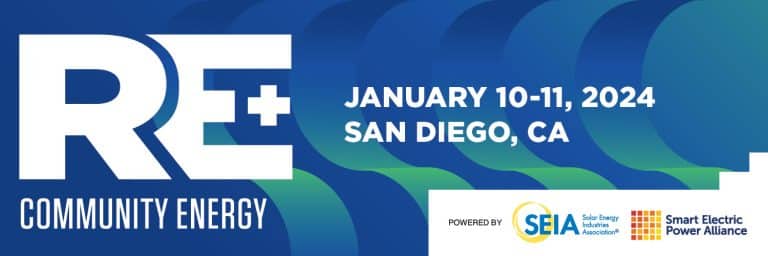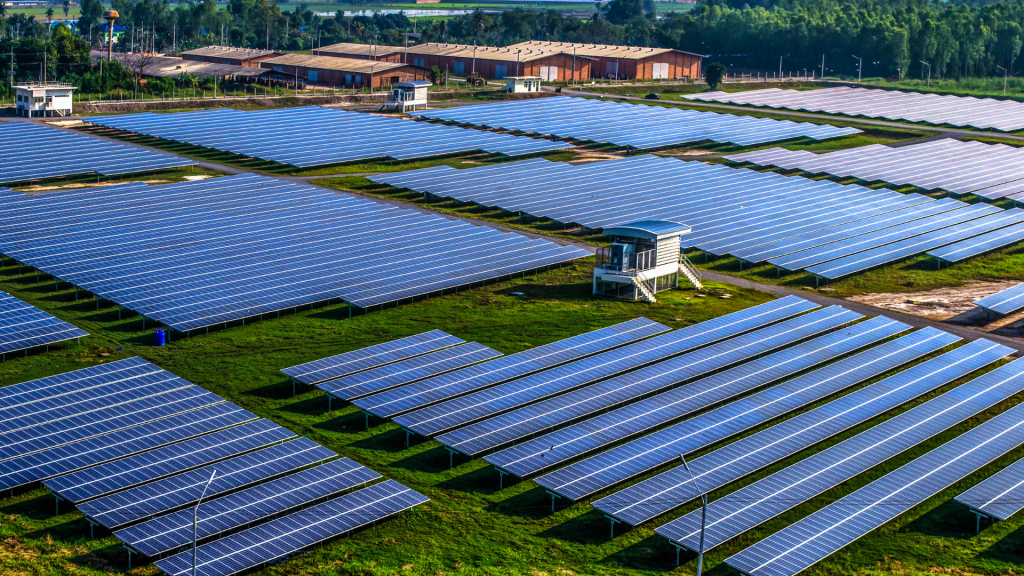The 2024 RE+ Community Energy conference brought together industry leaders, experts, and enthusiasts to explore the evolving landscape of renewable energy. The Solstice team attended sessions covering a range of topics, capturing major themes and challenges discussed at the event. Here’s an overview of what you may have missed, plus key takeaways from two of the most prominent panels: “The Future of Community Solar” and “How We Built Successful Community Solar.”
Here’s a snapshot of the major themes and insights shared. For deeper insights and discussion, connect with our Policy Team and Business Development Team.
Table of Contents
Major Themes and Topics Addressed
Community Solar Paired with Storage: A Necessity for Reliability
Integrating community solar projects with storage solutions was a prevailing theme, as California’s pending program is expected to lead the way. Speakers emphasized reliability and recognized that projects need storage to efficiently clean the grid and make economic sense. Illinois is also moving in this direction, with storage legislation a hot topic in this year’s legislative session.
UCB: Key Development in Inclusive Community Solar
Utility Consolidated Billing (UCB) remains a key variable for inclusive community solar. While it brings benefits from a customer experience perspective, it can prove challenging from a utility and developer standpoint due to the administrative burden of updating billing systems and the need for consistency in applying bill credits. In the end, UCB is seen as the future, offering a better customer experience and streamlining utility operations when designed and implemented properly. More on that below.
IX: A Significant Barrier to Deployment of Community Solar
The conversation surrounding community solar returned to a critical barrier and catalyst that shapes the future of nationwide deployment of distributed clean energy. Interconnection (IX) presents both challenges and opportunities within the community solar landscape. Navigating the complexities of IX requirements, timelines and costs, adhering to regulations, and understanding market dynamics is among the most significant challenges for industry stakeholders.
“Synthetic Community Solar” Approach
In illustrating the challenges posed by IX constraints and program caps in mature solar markets, the conversation touched upon innovative approaches sometimes referred to as “synthetic community solar” where distributed solar projects with community benefits can be built outside of established community solar programs. These approaches exemplify the industry’s creative response to barriers for deployment, highlighting how clean energy and environmental justice commitments can be merged through innovative mechanisms such as premium Renewable Energy Certificates (RECs). The community solar industry is increasingly becoming a facilitator of new models to connect communities with the benefits of clean energy, fostering innovation and encouraging partnerships between developers and large corporations.
Building Successful Community Solar: Industry Insights
The panel on building successful community solar, moderated by Caitlin Connelly from WoodMackenzie, brought together industry leaders who shared valuable insights into the challenges and triumphs within the community solar space.
Challenges in Billing and Customer Experience
The panel discussed nationwide inconsistency in utility billing practices, highlighting concerns about the lack of uniformity in applying bill credits correctly and on time. This inconsistency was seen as a substantial challenge affecting the overall customer experience within community solar programs. The panel emphasized the urgent need for improvements in utility billing practices to ensure a more streamlined and positive experience for subscribers.
Legislative Impacts and New Trends
The discussion touched upon the promise posed by 100% clean energy goals in states like Minnesota and Michigan. On the one hand, such legislative goals present significant opportunities for the community solar sector. On the other, interconnection challenges continue to get in the way.
Navigating Uncertainties and Reliability
The experts emphasized the need to navigate uncertainties effectively, particularly in states like California. In regions where community solar plays a crucial role in enhancing overall reliability, especially when paired with storage solutions, the panel stressed the importance of strategic planning and proactive measures. This insight underlines the industry’s commitment to maintaining a reliable and resilient community solar infrastructure.
As the community solar landscape continues to evolve, these insights from industry leaders provide a comprehensive understanding of the challenges faced and the strategies employed to build successful community solar programs. The industry’s dedication to enhancing customer experiences, navigating legislative complexities, and ensuring reliability positions community solar as a vital component of the clean energy transition.
Essential Aspects of a Community Solar Program
The panel highlighted essential aspects of community solar programs, emphasizing customer satisfaction, the importance of billing experience and UCB, and the importance of reliability, especially when paired with storage.
As the industry evolves, ensuring a positive and satisfactory experience for subscribers becomes a key metric for success. There’s a major need for deep engagement with stakeholders, especially with the qualification process for low-income customers continuing to be burdensome. Solstice sees self-attestation as the gold standard for low-income customers, simplifying the qualification process and reducing the burden on low-income families who otherwise must find ways to prove their income.
Navigating Challenges and Strategic Customer Acquisition
During the panel discussion on building successful community solar, experts delved into challenges and solutions for successful customer acquisition.
Challenges in Navigating Long Timelines
One notable challenge discussed was navigating long timelines, particularly in states like Illinois with intricate processes for allocating capacity. The panel highlighted the complexities that arise during the allocation of capacity, making it a cumbersome process for program administrators. The panel underscored a need for efficient solutions and streamlined procedures in such states to expedite project implementation. This challenge brings attention to the importance of regulatory frameworks and administrative processes that impact the timeline of community solar initiatives.
Solstice’s Commitment to Navigate Emerging Markets
As the community solar landscape continues to evolve, Solstice’s business development and policy team stands ready to provide support and expertise in navigating these dynamic markets. With a dedication to driving positive change in the renewable energy space, Solstice is well-equipped to address challenges and seize opportunities in community solar and beyond. If your team is navigating these challenges or exploring new opportunities, Solstice is here to help.
Contact our Business Development and Policy teams today to get hands-on support with your upcoming renewable energy projects.




